How crane lifts and investment has boosted offshore growth
27 October 2021
A period of spectacular lifts and plenty of wind farm investment suggest the offshore industry will continue to remain strong post-pandemic. Niamh Marriott reports
It is a busy time for offshore lifting contractors. At the top of the capacity scale recent months have seen Heerema’s semi-submersible crane vessel Sleipnir go from one job to the next.
The Dutch contractor set a new record for heaviest lift, for Equinor’s 12,050 tonne Johan Sverdrup processing platform (P2) jacket. This lift came after the inshore integration of the three P2 topside modules on behalf of client Aibel at the GMC yard in Gismarvik, Norway in May.
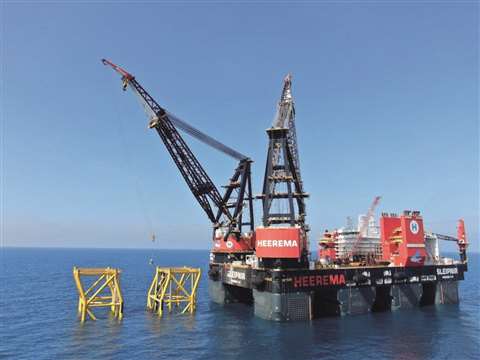 Sleipnir breaks records on the Johan Sverdrup Phase 2 development project 3
Sleipnir breaks records on the Johan Sverdrup Phase 2 development project 3
Sleipnir also transported and installed the six-legged, 2,852 tonne, 50 metre long jacket for the Hollandse Kust (zuid) (HKZ) offshore transformer platform in the Netherlands. The project is Sleipnir’s second on the HKZ project, with the installation of the HKZ alpha jacket in 2020.
Sleipnir and Aker BP
After that, Sleipnir transported and installed the Hod B platform, a normally unmanned installation wellhead platform that is part of the Valhall complex in the Norwegian sector of the North Sea, on behalf of client Aker BP. In addition to the Hod B installation, Heerema performed a crane exchange on a platform within the complex.
Also gearing up for large offshore jobs, Allseas has updated the capabilities of its vessel Pioneering Spirit with a new jacket lift system. Integral to the system are two 170 metre hinged beams with integrated tail extensions, built to install and remove entire jackets up to 20,000 tonnes in a single lift and able to operate in bad weather.
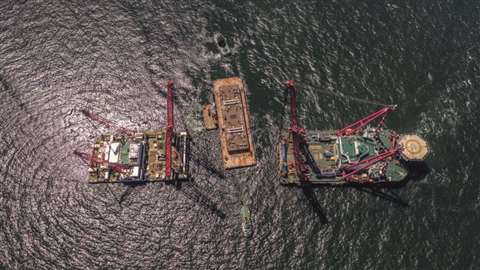 Scaldis completed a simultaneous and synchronised 5,000 tonne lift with its vessels Rambiz and Gulliver
Scaldis completed a simultaneous and synchronised 5,000 tonne lift with its vessels Rambiz and Gulliver
Working in tandem, Scaldis completed a simultaneous and synchronised 5,000 tonne lift with its vessels Rambiz and Gulliver in the Netherlands. “For this lift we created a copy of the actual lifts to be performed, by placing a test load pontoon on the transport barge, combined with a unique and safe rigging design,” says Scaldis project manager W. Zuidscherwoude. “This test lift has been in the making for over a year and a half. To see it all come together with a perfectly executed lift is a statement of the competence and capabilities of Rambiz, Gulliver and their respective crews.”
At the other end of the capacity scale Austrian crane manufacturer Palfinger sees an increasing demand for smaller and more compact platforms, including normally unmanned platforms. Its latest development is the fully electric wire luffing lattice boom crane DKW1600e, which has a double luffing system for the boom. The company says it makes the crane one of the safest offshore cranes ever built. It can handle the full 60 tonne load even if one of the luffing wires or winches should fail as the remaining rope can hold the boom in position while the load is being secured.
DEME Offshore
Offshore wind remains a fast-developing industry. Recognising this trend, a duo of upgrades for DEME Offshore have been arranged with Huisman as the company seeks to invest further in the offshore wind sector.
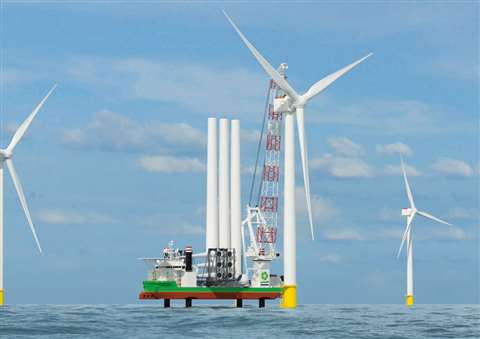 DEME’s Sea Installer will get a major crane upgrade with an increased capacity from 900 tonnes to 1,600 tonnes
DEME’s Sea Installer will get a major crane upgrade with an increased capacity from 900 tonnes to 1,600 tonnes
Its DP2 jack-up installation vessel Sea Installer will get a major crane upgrade with an increased capacity from 900 tonnes to 1,600 tonnes, increasing the capacity by 700 tonnes. The upgraded vessel will be deployed for the first time at the 800 megawatt Vineyard Wind 1 project, one of the first large-scale wind farms in the USA. It will be 62 large offshore turbines which each boast a 220 metre rotor, 107 metre blades and will be a staggering 248 metres high.
Marro Vreys, business unit director of wind turbine generators at DEME Offshore says, “We are willing to make the necessary investment in new technology to make sure that our fleet is ready for the future.”
The company has already installed wind turbines at 45 offshore wind farm projects across Europe and Asia and Sea installer is deployed at the Hornsea Two offshore wind farm in the UK.
Offshore lifting equipment specialist Huisman will also deliver a 2,300 tonne metre lifting spreader and a set of adaptive damping tugger winches to be installed onboard DEME’s offshore installation vessel Orion. The companies have worked together on optimising the spreader’s design to increase the safety and efficiency of monopile installation, enabling hands-free sling handling of monopiles, controlled remotely, and powered by an exchangeable battery pack.
Huisman Equipment BV
Carola de Vreede, communications officer at Huisman Equipment BV says, “We have seen offshore wind catching up big time to the oil and gas industry. Ultimately, the offshore wind sector needs high reliability at an affordable price.
“Huisman has been delivering various kinds of key mission equipment for the installation of foundations. This includes the 5,000 tonne crane for Jan De Nul’s Les Alizés vessel, as well as the 4,000 tonne offshore mast cranes for both DEME-CSBC and Boskalis.”
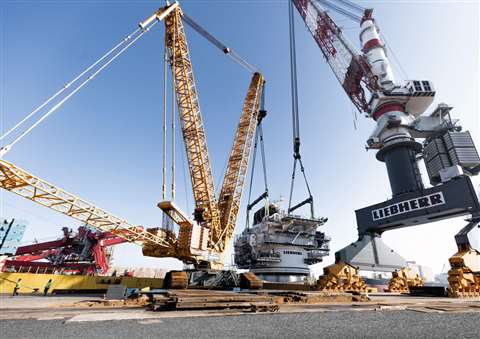 Construction of the OHT Alfa Lift vessel is making progress with the installation of the Liebherr HLC150000 crane
Construction of the OHT Alfa Lift vessel is making progress with the installation of the Liebherr HLC150000 crane
Developed for the global offshore wind market, the construction of the OHT Alfa Lift vessel is making progress. The vessel will be used to install the wind turbine foundations for the offshore wind farm Dogger Bank A & B, off the east coast of Yorkshire in the UK. Due to be delivered in early 2022, it will be the world’s first monohull vessel able to perform heavy lift crane operations when the main deck is submerged in offshore conditions and boasts a 3,000 tonne heavy lift crane.
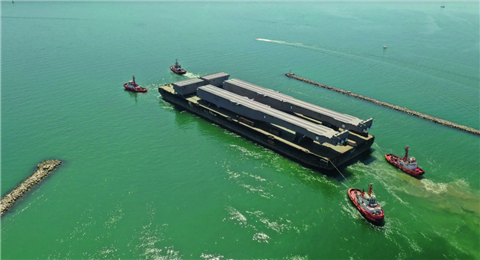 Allseas has updated the capabilities of its vessel Pioneering Spirit with a new jacket lift system
Allseas has updated the capabilities of its vessel Pioneering Spirit with a new jacket lift system
Already in operation in Europe, Spliethoff’s vessel Lady Anne Beau delivered the first four monopiles for Fryslân wind farm in the Netherlands. Spliethoff Group will perform 26 more shipments for the project in the coming months, transporting a total of 89 monopiles and 89 concrete work platforms (CWPs).
NOV will supply two GustoMSC NG-20000X self-propelled wind turbine installation jack-up vessel designs, known as the Cadeler X-Class, to Cosco Shipping Heavy Industry and Cadeler. The Cadeler X-Class is designed with 5,600 square metres of deck space and a carrying capacity of more than 17,600 tonnes, one of the largest in the industry. This new hybrid, DNV-certified, cyber-secure jack-up vessel is designed to transport and install seven complete 15 megawatt turbine sets or five sets of 20 plus megawatt turbines, a significant upgrade from prior designs. This expanded carrying capacity will reduce the number of vessel trips required per development and accelerate installation speed, thereby improving project economics while reducing the total carbon footprint of the installation process.
In addition to the overall jack-up design, NOV will supply the jacking system that lifts the vessel and cargo above the waterline to safely install wind turbines. Ready for delivery in 2024, the first NG-20000X jack-up vessel is contracted for one of the largest offshore wind farms, RWE’s 1.4 gigawatt Sofia wind park in the UK.
Mikkel Gleerup, Cadeler CEO, says, “We need to ensure that the new vessels will be as cutting-edge as the turbines we will be installing.”
In parallel, NOV is supplying new heavy-lift cranes for Cadeler’s existing O-Class vessels, Wind Orca and Wind Osprey, to upgrade the existing fleet’s capabilities to handle the next-generation of turbines.
Shimizu Corporation and Heerema Marine Contractors
Elsewhere in the world, Shimizu Corporation, one of the largest general contractors in Japan, and Heerema Marine Contractors, have entered into a co-operation agreement for the Japanese offshore wind market and will focus on installing turbine foundations. Shimizu was involved in the first offshore wind pilot project in Japan and intends to play a major role in the Japanese energy transition. Jeroen van Oosten, business unit director Wind at Heerema Marine Contractors, says, “We are happy and honoured to be working with a general contractor with a strong ambition to support the growth of offshore wind in Japan.”
Other movement in the sector includes heavy lift shipping and offshore transport contractor Jumbo, which is using heavy lift slings from Lankhorst Ropes to install offshore wind turbine transition pieces onto monopiles for the Yunlin Offshore Wind Farm in Taiwan. The slings will be used to lift and position 80 transition pieces, each weighing 450 tonnes, from the offshore vessel Jumbo Javelin, into what will be Taiwan’s first large multi-megawatt offshore wind project. The heavy lift crane vessel features two rotating mast cranes with a combined lifting capacity of 1,800 tonnes.
Despite massive renewable growth, the oil and gas industry remains strong, and cranes are still being used for the construction and maintenance of offshore sites. Carola de Vreede, communications officer at Huisman Equipment says, “Right now, the need for larger platforms has driven the need for larger cranes. The need for deeper depths in subsea operations, however, has come to a halt for where it is affecting new or upgraded equipment. This may change when the offshore oil and gas industry will return to traditional levels. We foresee something may need to happen.
“While there is a large drive for reducing the world’s carbon footprint, we see that oil and gas may be needed for a long time as the primary focus should be on reducing the most carbon-inefficient sources like coal.”
Favelle Favco Bhd’s (FFB) latest contract wins are a further sign of recovery for the oil and gas sector, says analysts at MIDF Amanah Investment Bank.
“Brent crude oil had been elevated in the first half of 2021 with the gradual curb of the pandemic and the increasing demand for the commodity, in addition to the recent OPEC+ decision to increase oil supply to 400,000 barrels per day in the next few months,” MIDF notes in a recent report.
It added that the improved energy market situation would give FFB’s clients enough assurance to start offshore projects again. The purchase orders are set to grow in 2021 after FFB’s subsidiaries received eight purchase orders for offshore cranes, tower cranes, compressor system, solar system and upgrading.
Malaysian oil companies
FFB’s Exact Group holds more than 20 live maintenance contracts with most oil majors in Malaysia, and supplies hybrid solar and wind turbines for offshore facilities as well as various automated analytical and maintenance systems, including pipeline monitoring and plant intelligence solutions.
Some companies are looking to combine their efforts for both renewables and the oil and gas industry. Specialist crane maker KenzFigee has opened a new UK office, workshop and storage facility in Brechin, Scotland, to accommodate the increasing demand it sees from the global offshore oil and gas, defence and renewables market.
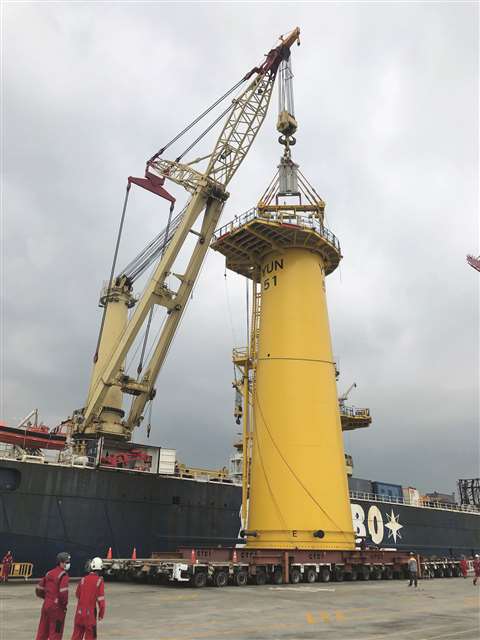 Jumbo is using heavy lift slings from Lankhorst Ropes to install offshore wind turbine transition pieces
Jumbo is using heavy lift slings from Lankhorst Ropes to install offshore wind turbine transition pieces
Barry Stewart, KenzFigee vice president, says, “The continued growth of the KenzFigee service and design brand in the oil and gas, and offshore renewables markets, has created the need to expand our premises. The new space, with a workshop of 650 square metres and a 2,000 square metre yard space, will create much needed additional capacity to support our expansion plans into renewables and deliver a project-centric working approach.”
MacGregor, part of Cargotec, will deliver two large, 120 foot double telescopic service cranes and one 50 foot telescopic stores crane for a self-propelled hopper dredge, being built for USA-based Manson Construction. It will be the largest ever self-propelled trailing suction hopper dredge built in the USA and will operate all over the country. The order was placed by Keppel AmFELS, Inc. and the cranes are planned to be delivered to the yard by the end of 2021, prior to delivery of the dredge in the first quarter of 2023. This model has been installed on a range of vessels in recent years, including fishing vessels in the USA Pacific Northwest.
MacGregor worked with the vessel owner-operator, Manson Construction, and the designer, USA-based Hockema Group, during the earlier design stage of the project to provide crane models that fit their requirements. The cranes will be built at MacGregor’s facility in Seattle, and the vessel will be built at Keppel AmFELS shipyard in Texas, USA.
Gantry overcomes obstacles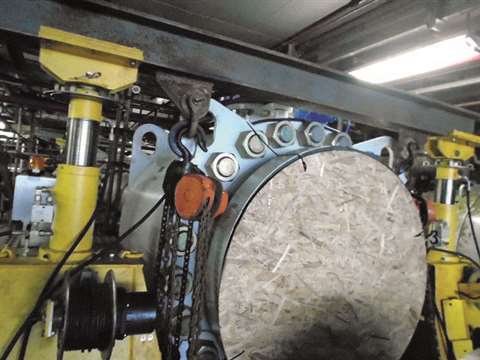 The ceiling height aboard the rig was so low that a mobile crane wouldn’t have had enough overhead space to operate The ceiling height aboard the rig was so low that a mobile crane wouldn’t have had enough overhead space to operate
Salt water, an explosive environment, and a low-clearance ceiling plagued Enaval, an environmental and energy consulting company, as it set out to replace process valves on a natural gas platform off the coast of Brazil. The ceiling height aboard the rig was so low that a mobile crane or similar lifting system wouldn’t have had enough overhead space to operate so the company opted for Enerpac’s super lift hydraulic gantry, as its compact size made it ideal for such a confined space. Each leg on the Enerpac gantry had self-contained pumps, valves and hydraulics to eliminate safety hazards presented by hoses and cables. The gantry comes standard with wireless controls, allowing the operator to move freely around the gantry while controlling the load. A custom paint job of the hydraulic gantry and stainless-steel cabinet for the legs prevented corrosion from the surrounding saltwater. At the request of Petrobras and Enaval, an ATEX-certified explosion-proof motor was added since the equipment was being used in an explosive environment. |
STAY CONNECTED


Receive the information you need when you need it through our world-leading magazines, newsletters and daily briefings.




